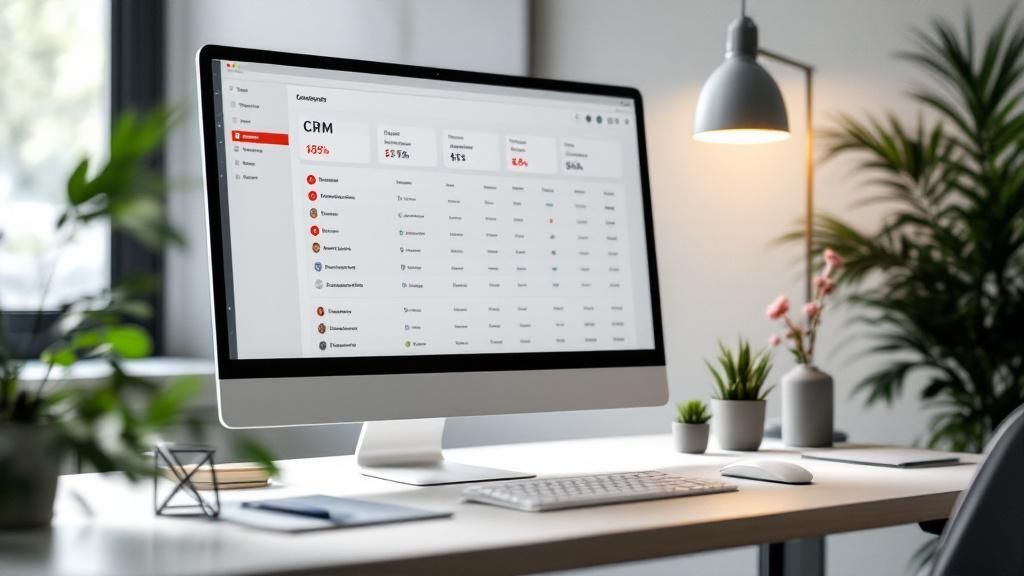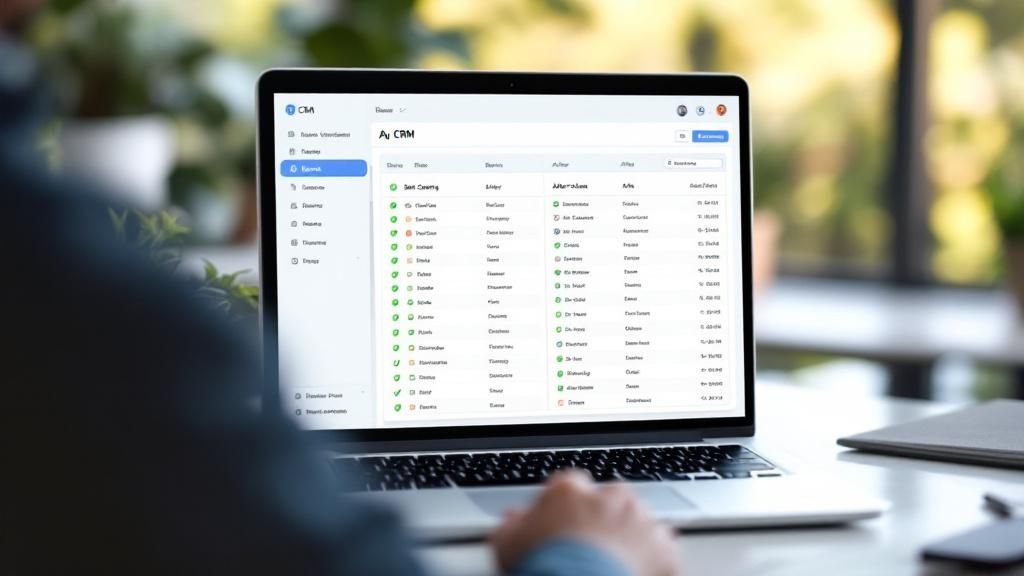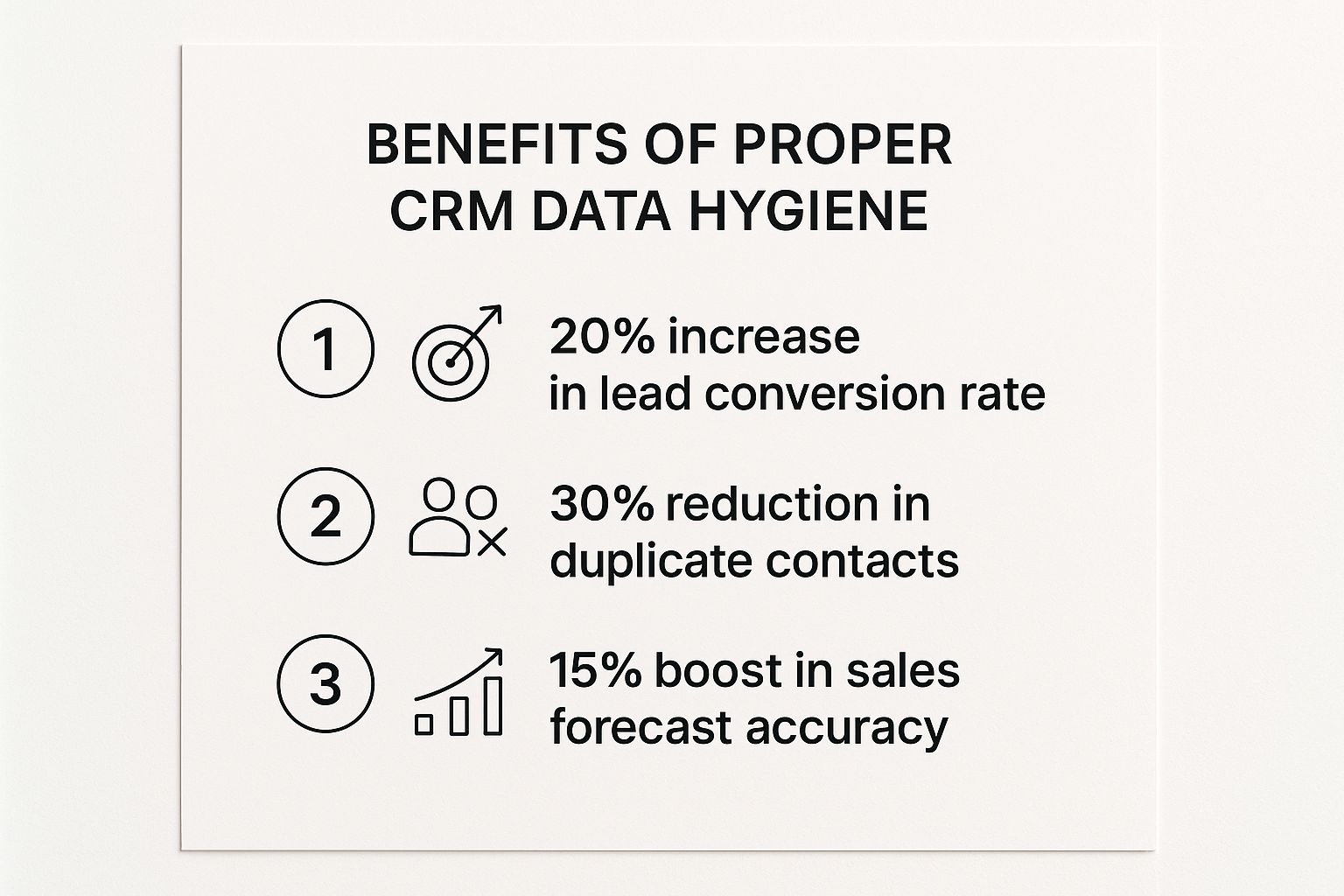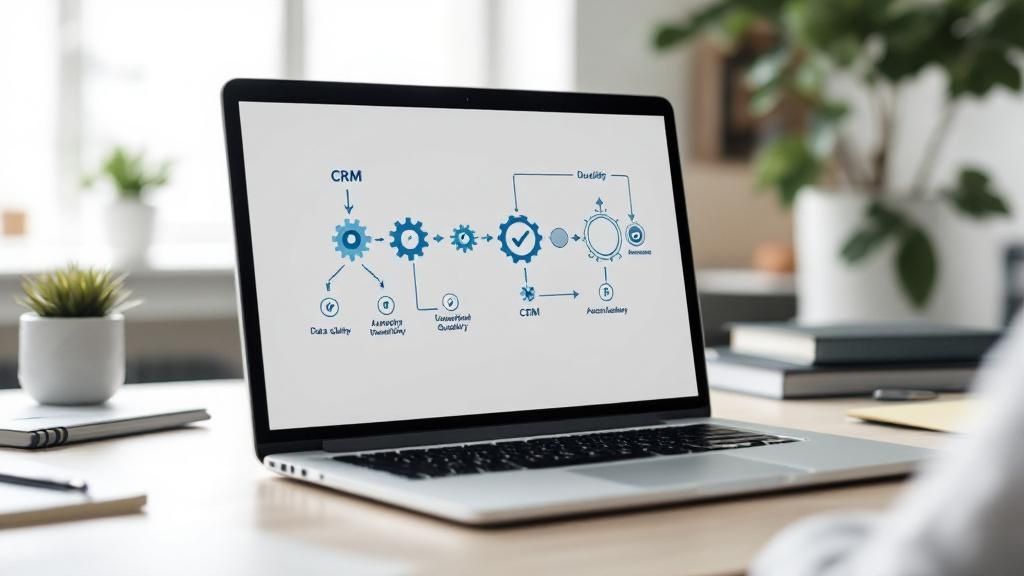Why CRM Data Hygiene Makes or Breaks Your Business
CRM data hygiene isn't just a technical to-do list item. It's absolutely essential to your business's success. Think of your CRM like the engine in your car. If you let the oil get dirty, eventually the engine will start to have problems and ultimately fail. But if you keep the oil clean, the engine runs smoothly. Similarly, clean data helps your sales and marketing teams thrive, while dirty data wastes resources and leads to missed opportunities. Understanding why CRM data hygiene is so important is key to revenue growth and the long-term health of your business.
The Impact of Clean Data on Your Bottom Line
Successful organizations use clean customer data to create stronger relationships and drive predictable revenue. For example, personalized marketing campaigns built on accurate customer demographics and preferences are far more effective than sending generic messages to everyone. This targeted approach results in higher conversion rates, increased customer lifetime value, and a better brand reputation. Clean data also empowers sales teams to prioritize leads effectively, avoid wasting time on outdated contacts, and close deals more quickly.
The Hidden Costs of Dirty Data
On the other hand, a CRM full of inaccurate information becomes a serious problem. Outdated contact information, duplicate records, and incomplete data can sabotage even the best efforts. A 2022 global study by Validity surveyed 1,241 CRM users and discovered that over 50% of organizations regularly experience data hygiene problems. Up to 70% struggle to integrate data from multiple sources. Find more detailed statistics here These problems lead to wasted marketing budgets, frustrated sales representatives, and missed revenue goals. Understanding retail marketing and the role of clean data is crucial for business growth.
Identifying the Warning Signs
Recognizing the signs of poor CRM data hygiene is the first step towards fixing it. Here are some key indicators:
- Low conversion rates: Your marketing campaigns aren't connecting with your intended audience.
- High bounce rates: Emails are being returned because of invalid addresses.
- Inaccurate sales forecasts: Your sales predictions are consistently wrong.
- Frustrated sales teams: Sales reps are losing valuable time pursuing leads that go nowhere.
- Inconsistent reporting: Getting reliable reports is a constant challenge.
These problems can indicate deeper issues with your data management procedures. A one-time data cleanup isn't enough. You need to create and implement strategies for ongoing CRM data hygiene. This proactive approach will save you time, money, and frustration down the road. Addressing the root causes of data decay is critical for sustainable data quality and getting the most out of your CRM investment.
The Real Cost of Dirty CRM Data on Your Revenue

Inaccurate data in your CRM system can be more than just a minor annoyance. It can quietly but significantly impact your revenue, leading to hidden costs that accumulate over time. These costs range from wasted marketing efforts to missed sales opportunities. Understanding these hidden costs is the first step towards recognizing the importance of CRM data hygiene.
Wasted Marketing Spend and Lost Opportunities
One of the most substantial costs associated with dirty data is wasted marketing spend. Sending promotional emails to outdated addresses results in high bounce rates and low engagement. Targeting the wrong demographics due to inaccurate information further reduces the effectiveness of your campaigns. This ultimately means fewer conversions and a lower return on your marketing investment. Potential customers who might have been interested in your products or services never receive your message, leading to lost opportunities. Learn more about effective strategies in our article about B2B sales lead generation.
The Drain on Sales Productivity
Dirty data also has a major impact on sales team productivity. Sales representatives waste valuable time pursuing leads with outdated contact information or incorrect details. This lost time translates directly into fewer opportunities to connect with qualified prospects and close deals. Inaccurate data can also skew sales forecasts, making it difficult to plan effectively and allocate resources strategically. According to Data Axle USA, poor CRM data cleanliness can lead to significant financial losses, with estimates suggesting businesses can lose up to 12% of their revenue due to inaccurate or outdated data. Explore this topic further.
Damaged Customer Relationships and Brand Reputation
Beyond the direct financial impact, dirty data can damage your brand's reputation. Incorrect information can lead to frustrating customer experiences, such as receiving irrelevant communications or being contacted through preferred channels. These negative interactions decrease customer satisfaction and can result in lost business and negative word-of-mouth referrals. In today’s competitive landscape, a positive brand image is essential, and dirty data can significantly undermine those efforts.
Calculating the ROI of Data Hygiene
While the costs of dirty data are considerable, the return on investment (ROI) from implementing robust CRM data hygiene practices is even more significant. Improved marketing effectiveness, increased sales productivity, and stronger customer relationships all contribute to a healthier bottom line. Investing in data hygiene is an investment in the long-term success of your business.
Practical Frameworks for Quantifying Impact
Understanding the financial ramifications of poor data quality requires a strategic approach. Consider the following factors when assessing the costs within your organization:
- Cost per lead: How much do you spend acquiring a lead, and what percentage of those leads are wasted due to bad data?
- Sales cycle length: Does inaccurate data lengthen the time it takes to close a deal?
- Customer churn rate: Are customers leaving due to negative experiences stemming from incorrect information?
By analyzing these metrics, you can start to quantify the true cost of dirty data and justify the investment in data hygiene initiatives. You might be interested in learning more about effective lead generation strategies: How to master B2B sales lead generation. Demonstrating the value of clean data to stakeholders is key to prioritizing data hygiene within your organization. Clean CRM data is an investment that yields significant returns through increased revenue and improved customer relationships.
How Customer Data Degrades and What You Can Do About It

Your CRM data is constantly changing. Understanding these shifts, especially how data degrades, is vital for maintaining effective CRM data hygiene. This means recognizing not only that data changes, but also how different information deteriorates at different speeds. This knowledge helps you prioritize your data hygiene efforts for maximum impact.
Understanding the Decay Lifecycle
Like groceries, different data points have different "shelf lives." Job titles, for example, change frequently with promotions or career moves. Email addresses become outdated as people switch jobs or personal accounts. Even company names and addresses can change due to mergers, acquisitions, or relocations. These changes contribute to data decay, which slowly diminishes the accuracy and reliability of your data.
Consider a sales representative trying to reach a lead using an old email address. The bounced message wastes the rep's time and represents a missed opportunity. Inaccurate data also skews marketing campaigns, leading to wasted ad spend and poor lead generation. This has a ripple effect across the sales pipeline, affecting everything from lead qualification to sales forecasts.
A 2024 industry report by ZoomInfo highlights the importance of CRM hygiene, revealing annual CRM data decay rates of about 34%. Without proactive data cleansing, a third of a company's contact records could be inaccurate or obsolete each year. Discover more insights about CRM hygiene
Proactive Strategies to Combat Data Decay
Several proactive strategies can slow data decay and preserve database integrity, allowing businesses to stay ahead of data degradation and ensure the CRM remains a valuable tool.
-
Regular Data Audits: Schedule regular reviews of your CRM data to find and fix inaccuracies.
-
Data Validation at Entry: Use tools and processes to verify data accuracy as it's entered, preventing bad data from getting into the system. This might include email verification tools or standardized input fields for phone numbers and addresses.
-
Automated Data Updates: Integrate your CRM with data enrichment services to automatically update contact and company information. Services like Salesloop.io can automate much of this process.
-
Data Enrichment: Regularly enhance existing records with more information for a richer understanding of your customers.
Identifying High-Risk Data Segments
To optimize data hygiene efforts, pinpoint high-risk data segments. These are the data points most prone to decay, based on factors like industry dynamics or customer behavior. For example, in B2B sales, contact information for people in rapidly changing industries may need more frequent updates.
Prioritizing these high-risk segments focuses resources where they'll have the biggest impact. This targeted approach maximizes ROI on CRM data hygiene efforts. Implement early warning systems to flag potentially outdated information before it becomes a problem. For example, integrating data quality alerts in your CRM can notify you of unusual changes or inconsistencies, prompting immediate action. These strategies ensure your CRM data remains a reliable source of truth, empowering you to make informed decisions and build stronger customer relationships.
Building Bulletproof CRM Data Hygiene Practices
Stop letting your CRM become a disorganized mess. Instead, create practices that turn chaotic customer data into a valuable business tool. This means establishing strong procedures and building a company-wide culture that values data accuracy.
Establishing Data Entry Standards
Prevention is key. Setting clear data entry standards is the first step in preventing dirty data. This involves defining specific formats for every field, from phone numbers and email addresses to company names and job titles. For example, requiring a consistent format for phone numbers (e.g., +1-XXX-XXX-XXXX) avoids variations and makes later data analysis much simpler.
Adding dropdown menus for common fields like industry or job title reduces typos and ensures data consistency. This initial effort greatly reduces the need for extensive cleanup later.
Automating Validation and Standardization
Manual data entry is always susceptible to errors. Automating validation at the point of entry catches mistakes before they take root in your system. This might involve using email verification tools, address validators like Melissa Data, or even custom scripts to identify data inconsistencies.
Standardization protocols automatically format data into a consistent structure, ensuring uniformity across your CRM and simplifying data analysis and reporting. These automated processes save time and resources, allowing your team to focus on more strategic tasks.
Training Your Team for Consistent Data Quality
Human error can still happen, even with automation. Investing in team training on data entry best practices is essential. This means educating staff on the importance of CRM data hygiene and the specific procedures they should follow. Regular refresher courses and practical exercises reinforce these procedures and promote consistent data quality across your organization.
This builds a culture of data quality where everyone understands their role in maintaining a clean CRM.

The infographic above illustrates the benefits of good CRM data hygiene, demonstrating the positive impact on lead conversion, duplicate contacts, and sales forecast accuracy. As shown, implementing effective CRM data hygiene practices can result in a 20% increase in lead conversion rates, a 30% reduction in duplicate contacts, and a 15% improvement in sales forecast accuracy. These improvements translate directly to higher revenue and better overall business performance, showcasing the importance of prioritizing data quality.
To further illustrate the different approaches to CRM data hygiene, let's examine a comparison of preventive and reactive strategies. The following table highlights the key differences in implementation, cost, and effectiveness.
CRM Data Hygiene Best Practices Comparison
| Practice Type | Implementation Time | Cost Level | Effectiveness | Best For |
|---|---|---|---|---|
| Preventive (e.g., data validation, standardization) | Short-term | Low | High (long-term) | Preventing issues before they occur |
| Reactive (e.g., data cleansing, deduplication) | Long-term | High | Moderate (short-term) | Addressing existing data quality issues |
As the table shows, while reactive strategies are necessary for addressing existing data problems, preventive measures offer a more efficient and cost-effective long-term solution.
Building Sustainable Hygiene Workflows
Data hygiene isn't a one-time fix; it's a continuous process. Create sustainable workflows that work with your resources and grow with your business. This could involve scheduling regular data audits to find and correct errors, implementing automated data enrichment tools to keep information current, or integrating your CRM with other systems to streamline data flow. Services like Salesloop.io can automate many of these tasks. Establishing clear accountability ensures data quality is everyone's responsibility, not just the IT department's, protecting your data's long-term integrity. This proactive approach keeps your CRM clean, accurate, and a powerful tool for your business.
Smart Tools That Actually Improve Your CRM Data Quality
Manual data cleaning is a tedious process, and often yields disappointing results. Thankfully, automated tools can drastically improve your CRM data hygiene without breaking the bank. Let's cut through the noise and explore some effective data cleansing tools, and how to choose the right one for your business.
Automating Your CRM Data Hygiene Efforts
When evaluating CRM data quality tools, it’s helpful to adopt a broader perspective on building sustainable systems. Thinking about sustainability in other areas, like sustainable food packaging strategies, can inform your tool selection. This approach encourages you to look for solutions offering a range of automation features, including:
- Data Validation: Real-time validation tools verify information like email addresses and phone numbers as they are entered, preventing bad data from entering your CRM.
- Standardization: Automated standardization ensures data consistency by formatting information uniformly, making analysis and reporting much simpler.
- Deduplication: Deduplication tools identify and merge duplicate records, eliminating redundant information and improving accuracy. This helps prevent inflated lead counts and skewed campaign results.
- Enrichment: Enrichment tools automatically add valuable information to existing records, like company size, industry, or social media profiles, giving you a more comprehensive view of your customers.
Choosing the Right Tools for Your Needs
Not all data hygiene tools are the same. Here are some key factors to consider when making your selection:
- CRM Integration: Seamless integration with your current CRM platform is essential for smooth data flow and minimal workflow disruption.
- Features: Carefully evaluate the features of each tool and select those that align with your specific data quality challenges. Do you primarily need robust deduplication, or is real-time validation more critical?
- Pricing: Data hygiene tools range from free, open-source options to enterprise-level solutions with subscription fees. Select a tool that aligns with your budget and delivers the necessary features. Remember, investing in data hygiene pays off in the long run through better sales and marketing performance.
- Ease of Use: A user-friendly interface is key for efficient implementation and adoption by your team. Prioritize tools that are intuitive and easy to navigate.
The Power of AI and Machine Learning
Artificial intelligence (AI) and machine learning are transforming data quality management. These technologies can analyze vast datasets to identify patterns, predict data decay, and automate complex cleansing tasks with greater accuracy than traditional methods.
For instance, AI-powered tools can identify and correct inconsistencies in data formatting, flag potentially outdated information, and even predict which leads are most likely to convert based on their data profile. This allows sales and marketing teams to concentrate on the most promising opportunities. Learn more in our article about How to master automating your lead generation.

Implementing and Measuring Success
Implementation timelines vary depending on the complexity of your CRM and the solution you choose. Begin with a clear plan, prioritize your data quality objectives, and provide adequate team training.
To measure the effectiveness of your technology investments, track key metrics like:
- Data Accuracy: Regularly assess the accuracy of your CRM data through random record sampling and verification.
- Conversion Rates: Monitor your lead conversion rates to see if data quality improvements translate into increased sales.
- Sales Productivity: Track the amount of time your sales team dedicates to administrative tasks versus engaging with prospects. Automated tools should free up their time for more valuable activities.
- Marketing ROI: Measure the return on investment for your marketing campaigns by tracking metrics like click-through rates, conversion rates, and cost per lead. Clean data improves targeting and campaign effectiveness.
The following table provides a comparison of some popular CRM data hygiene tools:
CRM Data Hygiene Tools Feature Matrix
Side-by-side comparison of popular data hygiene tools showing key features, pricing models, and integration capabilities
| Tool Name | Key Features | Pricing Model | CRM Integration | Best Use Case |
|---|---|---|---|---|
| Example Tool 1 | Data validation, Deduplication, Enrichment | Subscription based | Salesforce, HubSpot | Businesses looking for a comprehensive solution |
| Example Tool 2 | Real-time validation, Standardization | Freemium | Microsoft Dynamics 365 | Small to medium businesses with limited budgets |
| Example Tool 3 | Deduplication, Enrichment, Reporting | Per-record pricing | Various | Businesses with large datasets and complex needs |
This table showcases how different tools cater to varying needs and budgets. Choosing the right tool requires careful consideration of your specific requirements.
By selecting and implementing the right tools, you can transform your CRM from a source of frustration to a driver of growth. Investing in CRM data hygiene is an investment in the future of your business. Clean data empowers better decision-making, strengthens customer relationships, and ultimately, boosts revenue.
Measuring Success and Sustaining Long-Term Data Quality
You can't improve what you don't measure. This holds true for CRM data hygiene. This section explores tracking the right metrics. We'll focus on those demonstrating real business impact, not just technical improvements. By establishing key performance indicators (KPIs), you can prove the value of clean data. This also helps justify ongoing investment in data quality.
Establishing Meaningful KPIs
Effective KPIs go beyond simply measuring duplicate records. They focus on the impact of clean data on core business objectives.
- Lead Conversion Rates: Does clean data result in more qualified leads and better conversion?
- Sales Cycle Length: Does accurate data shorten the sales cycle and help close deals faster?
- Customer Retention Rates: Do strong customer relationships, built on reliable data, improve retention?
- Return on Marketing Investment (ROMI): Does cleaner data make marketing campaigns more effective, leading to higher ROMI?
Tracking these KPIs demonstrates the value of CRM data hygiene to stakeholders. This justifies continuous allocation of resources for data quality.
Creating Visible Data Quality Dashboards
Dashboards are effective for communicating data quality status. They make data quality transparent across the organization, promoting accountability and continuous improvement. A good dashboard clearly presents progress towards data quality goals. It should highlight both successes and areas needing attention.
For example, visually tracking lead conversion rates over time reveals the positive impact of improved data accuracy. This visualization helps everyone understand the importance of data quality. It connects it directly to business success. Learn more in our article about How to master sales process optimization.
Implementing Sustainable Data Hygiene Practices
Sustaining long-term data quality requires ongoing effort and organizational change. It's more than a one-time fix.
- Staff Training Programs: Regular training reinforces best practices for data entry and fosters a data-driven culture.
- Regular Audit Schedules: Periodic audits, whether quarterly, bi-annual, or annual, identify emerging data quality issues early. The frequency depends on your specific industry and data volume.
- Continuous Improvement Processes: Systems for feedback and continuous improvement ensure data hygiene practices adapt to your evolving business needs.
These practices prioritize data quality, making your CRM a valuable and trusted resource.
Avoiding Common Pitfalls
Many data quality initiatives fail due to preventable pitfalls:
- Lack of Executive Sponsorship: Without leadership buy-in, data quality initiatives often lack traction and resources.
- Insufficient Staff Training: Inadequate training can lead to inconsistent data entry, undermining data hygiene efforts.
- Ignoring Data Decay: Data quality is not static. Ignoring data decay renders previous efforts ineffective.
Proactively addressing these challenges helps maintain momentum and achieve lasting data quality.
Organizational Changes for Long-Term Success
True long-term data quality success depends on organizational changes:
- Data Governance Policies: Formal policies prioritize and manage data quality across the organization.
- Data Ownership: Assigning data ownership creates accountability for data accuracy. Each team member is responsible for specific data elements.
- Cross-Functional Collaboration: Breaking down data silos and fostering interdepartmental communication improves data consistency and minimizes errors.
These changes cultivate a data-driven culture, weaving data quality into the fabric of your business operations.
By implementing these strategies and avoiding common pitfalls, CRM data hygiene becomes an integral part of your operations, driving growth and success, not just a temporary project.
Ready to improve your sales outreach and boost conversion rates? Discover the power of Salesloop.io today!





